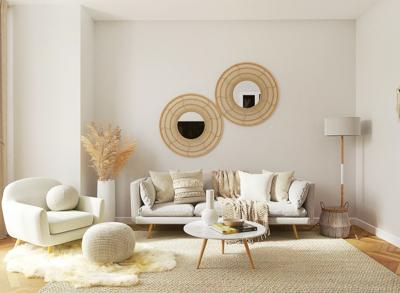
A home is more than a mere shelter; it's a profoundly personal haven that significantly affects your everyday wellness. How you design your living space, including the choice of wall colors and furniture placement, plays a critical role in shaping your emotional state, physical health, and general life satisfaction. These design elements can collectively create an environment that uplifts or dampens your daily experiences.
This article delves into the various aspects of home design and how they contribute to creating a haven that nurtures and uplifts.
The Psychology of Space and Color
Understanding the psychology of space and color is fundamental in home design. Colors have profound psychological effects. For instance, shades of blue can impart a sense of tranquility, while reds can invigorate and stimulate. The spatial layout of your room also plays a pivotal role in how you perceive and interact with the environment.
A well-arranged space can foster feelings of freedom and openness, whereas a cluttered or poorly planned space can lead to feelings of restriction and discomfort. Thoughtful color choices and strategic spatial planning are essential in creating an environment that positively impacts mental and physical health, enhancing your overall quality of life.
Importance of Personalization
Personalization is a crucial aspect of making a house feel like a home. It's about infusing your unique identity into the living space. This personalization can be achieved through various means, such as displaying family photographs, hanging personally meaningful artwork, or arranging cherished mementos. These elements do more than decorate; they narrate a personal story and create a sense of belonging and warmth.
Personalization in home design enables you to see reflections of yourself in your surroundings, thereby establishing a deeper emotional connection with your living space. This sense of personalized comfort is essential in creating a living environment where you can truly relax and feel at ease.
Functional Design and Well-being
Functional design is the cornerstone of a healthy and comfortable living environment. It involves more than mere aesthetics; it's about creating practical spaces conducive to everyday living. This includes ergonomic considerations in furniture selection, which support physical health and comfort. Adequate lighting is another critical aspect, influencing mood and the ability to perform tasks efficiently.
Efficient use of space is also essential, allowing for smooth movement and reducing clutter, which minimizes stress. A functionally designed home pleases the eye and seamlessly supports daily activities, contributing to a reduction in stress and an increase in productivity and overall well-being.
Sustainable and Healthy Living
Embracing sustainability in home design is a dual benefit—aiding both environmental conservation and personal health. This approach involves using eco-friendly materials that are less harmful to the environment and healthier for inhabitants.
Ensure good indoor air quality to reduce pollutants and allergens. To enhance this connection to nature, integrate green spaces, such as indoor plants or garden areas. This can help promote a healthier lifestyle and foster a sense of peace and well-being in your home.
The Role of Technology in Home Design
Integrating modern technology has transformed home design, making your living space more comfortable and convenient. Smart home systems are at the forefront of this revolution. They automate essential home functions like lighting, temperature control, and security systems.
This automation creates a living environment that is more efficient safer and intuitively responsive to your inhabitants' needs and preferences. Technology in home design simplifies daily tasks and enhances the quality of living, making your home smarter and more adaptable to your changing lifestyle.
Rest and Relaxation Spaces
Designating specific areas in your home for rest is essential for nurturing mental and physical well-being. These tranquil sanctuaries provide the perfect setting for decompression and rejuvenation, whether a book-lined reading nook, a garden brimming with nature's calm, or a quiet meditation space.
In creating such spaces, it's also important to dispose of mattresses that no longer provide the necessary support, ensuring a restful environment. These personal retreats offer a haven for you and your inhabitants to unwind and reflect, playing a critical role in maintaining a balanced and peaceful home environment away from the fast pace of daily life.
Incorporating Art and Creativity
Art and creativity are key components in elevating your living space's aesthetic and emotional appeal. Artistic elements can range from paintings and sculptures to handmade crafts, each adding a unique touch to the home. Art can inspire, evoke emotions, and stimulate thought, thereby enriching the living experience.
Including personal art preferences beautifies the space and creates an environment that reflects individual tastes and personalities. This incorporation of art and creativity makes a home not just a place to live but a space continuously offering visual and emotional stimulation.
Conclusion
The design of your home is a powerful tool in shaping your daily experiences and well-being. By understanding and applying the principles of design, personalization, functionality, and sustainability, you can transform your living space into havens that support and enrich your life. The goal is to create a home that shelters, nurtures, and revitalizes, making every day a step towards greater well-being.




(0) comments
We welcome your comments
Log In
Post a comment as Guest
Keep it Clean. Please avoid obscene, vulgar, lewd, racist or sexually-oriented language.
PLEASE TURN OFF YOUR CAPS LOCK.
Don't Threaten. Threats of harming another person will not be tolerated.
Be Truthful. Don't knowingly lie about anyone or anything.
Be Nice. No racism, sexism or any sort of -ism that is degrading to another person.
Be Proactive. Use the 'Report' link on each comment to let us know of abusive posts.
Share with Us. We'd love to hear eyewitness accounts, the history behind an article.